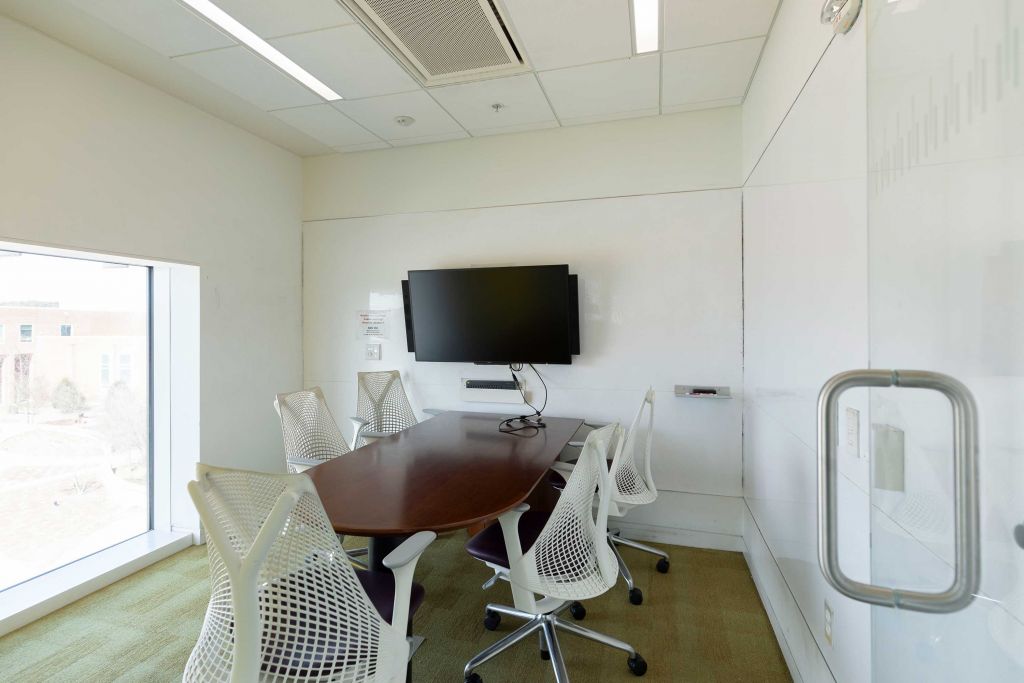Study Rooms Observational Study Report
We observed how patrons use the study rooms at the D. H. Hill Jr. Library and the James B. Hunt Jr. Library to inform future choices about technologies and the size of rooms.

Overview
Libraries staff have been discussing the current state of the 127 study rooms at the D. H. Hill Jr. Library and the James B. Hunt Jr. Library and how we want to improve them going forward. To provide some data to inform these conversations, we did an observational study in late October and early November of 2023. We observed five study rooms at the Hill Library and five study rooms at the Hunt Library, three times each during busy hours.
How much do patrons use the wall-mounted screens in each study room?
Maintenance of the technologies for enabling connections to these screens in 56 study rooms at the Hill Library and 71 at the Hunt Library is challenging, which means that, at any given time, patrons have difficulties using the screens in some rooms. We have discussed a possible future in which not all rooms have screens.
Observations: There were only two instances of people using the screens (out of the 27 observations when people were in the rooms).
How many patrons are usually in a study room together?
Most of the rooms are for 4–6 people. Are those sizes optimal? Increased use of study rooms since 2020 by solo individuals has led us to consider the need for a mix that includes more rooms that are smaller.
Observations:
- Median occupancy: 1.5.
- Occupancy rate: 35% (number of people divided by capacity of the room).
- Times (out of 30) when 0 people were in a room: 3.
- Times (out of 30) when 1 person was in a room: 12 (40%).
Note: Nine of the 10 rooms we observed have capacities of 4, 5, and 6; one has a capacity of 10.
How much do patrons use whiteboards, writable tables, and writable walls in the study rooms?
Observations: In 12 out of 27 observations (44%) someone was writing on whiteboards, tables, or walls.
When groups use study rooms, are they collaborating or working individually?
Observations: Of the 15 observations when there were at least two people in the rooms, 10 groups were talking to each other and interacting. The other five groups were not interacting with each other at the time of the observation.
Do we need dedicated Video Conferencing Rooms?
We have observed increased use of study rooms for video conferencing by solo individuals.
Observations: The observations do not shed light on this topic. In the two cases when patrons were using the rooms’ screens, it was not for video conferencing. The observer could not tell whether patrons in the study rooms were or were not engaged in video conferences on their laptops or phones.
Recommendations
- The Libraries’ Patron Computing Product Team should consider the findings of this study as they consider the future of study rooms.
- In the future, find answers to the questions:
- Why do patrons so seldom use the screens in study rooms? Is it because they do not need them, or is it due to technical difficulties?
- Do we need dedicated Video Conferencing Rooms?
How We Did It
We observed study rooms 30 times, 15 times at the Hill Library and 15 times at the Hunt Library. We observed:
- five of the most frequently reserved study rooms at the Hill Library, three times each: rooms 4419, 5419, 5426, 8419, and 9413.
- five of the most frequently reserved study rooms at the Hunt Library, three times each: rooms 2304, 2305, 2323, 3214, and 3215.
- on Thursdays, the busiest day for reservations at both the Hill Library and the Hunt Library (October 26, November 2, and November 9, 2023).
- during the hours most frequently reserved (at the Hill Library: 10–11am and 12–1pm, and at the Hunt Library: 10–11am, 12–1pm, and 7–8pm).
- during a busy time of the semester, late October and early November.
During the observations we noted:
- use of the room’s screen.
- the number of people in the room.
- use of whiteboards, writable tables, and writable walls.
- collaboration of groups in the rooms.
- patrons engaged in video conferences.
Related findings from another study
The Student Experience Survey: Fall 2023 found:
- Study rooms were in the top three of respondents' favorite places. One student wrote "I feel like I have my own and beautiful office."
- 88% and 86% of respondents were somewhat or very satisfied with the study rooms in the Hill Library and the Hunt Library, respectively.
- When asked what they would change, respondents wrote about:
- The reservation process/policy. "A lot of reserved room do not get used by the person who reserved them."
- Focus rooms for individual use. "I wish there were more individual study rooms (single person). It makes me upset when a single person reserves a room with 10 seats and takes that space away from large groups that need it." "Maybe make them smaller to create more rooms."
- More outlets. "Including the power extension towers in every room."
- Lighting. "The lighting, to be more orange and relaxing tones." "Sometimes they feel a little dark even with the lights on."
- Technology that works reliably. "Some of the keyboards and TVs do not work properly, so it would be nice if they worked in all rooms."
